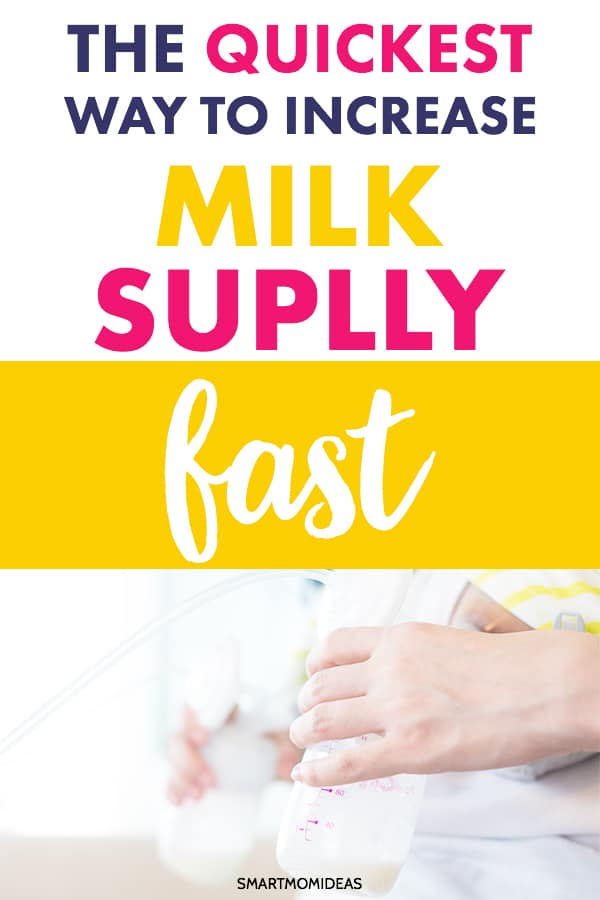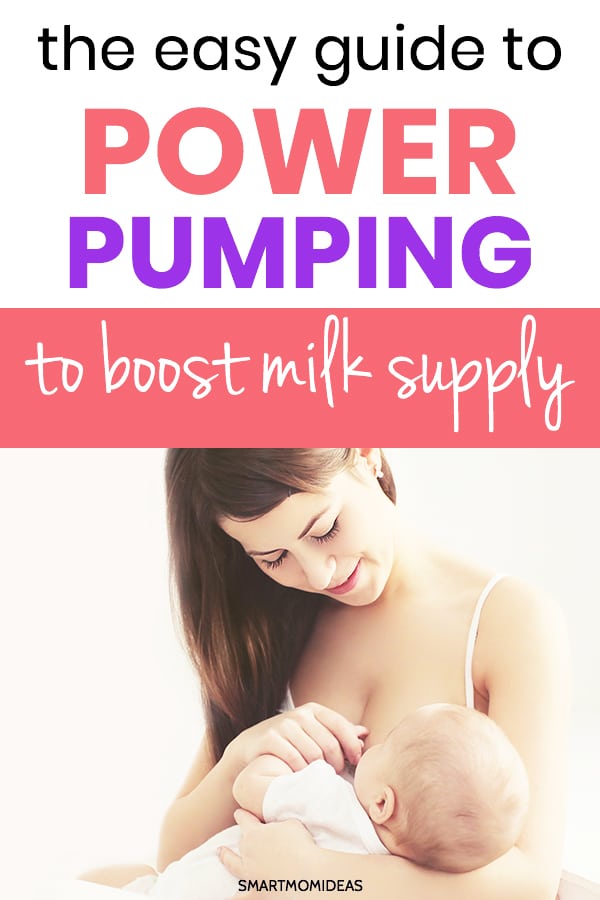Increase your milk supply fast with power pumping

Are you worried about a low milk supply? Or if baby is getting enough milk?
You’re not alone, mama, believe me!! Most new moms worry about their milk supply and lots of new moms give up on breastfeeding because they’re worried they don’t have enough milk.
But there are some effective things you can try to boost your milk supply.
You may have already tried these delicious lactation recipes to help boost your supply. And when you’re ready for something a bit more powerful, power pumping is a great option.
I tried lots of things to increase my milk supply – as a mom of twins I only had enough milk for one child!!
So here’s my easy guide to increase your milk supply fast using power pumping.
CAVEAT: If you’re worried about your baby gaining weight or any other medical issue, please see an appropriate medical professional immediately. I’m not a lactation specialist but I’m sharing tips that worked for me and lots of other moms. Please remember that every mom and baby is different and power pumping may not work for you. Always speak to a lactation specialist before starting power pumping.
Why Use Power Pumping to Increase Your Milk Supply Fast
Breastfeeding is a journey.
One week it can be going great – then a week later breastfeeding suddenly seems tough again!!
And there are lots of things that can affect your milk supply, such as
- Dropping night feeds
- Scheduled feeding rather than breastfeeding on demand
- Baby struggling to latch
- Mom having a cold or flu source
- Mom under stress
How to Tell if Baby is Getting Enough Milk
Once your body get used to baby’s demand for milk, your breasts will lose that uncomfortable overfull engorgement. Phew!!
But it can be difficult to tell if baby is actually getting enough milk. So how can you tell?
Ask these questions:
How many wet and dirty diapers does baby produce in a day?
Newborns should have 6 wet diapers and 3-4 dirty diapers a day.
From one month old, babies should have between 4-6 wet nappies a day. Find out if you baby is producing enough wet and dirty diapers a day with this helpful chart.
How does your baby seem to you?
Does baby seem satisfied and happy after a feed? Or does baby seem fussy?
If you’re concerned about your milk supply, it’s a good idea to track baby’s mood after feeding with a simple breastfeeding tracker. I’ve rounded up 11 of the best here.
The la Leche League list the following symptoms of dehydration in babies:
listlessness, weak cry, dry mouth and eyes, lethargic.
And remember that you must contact an appropriate medical professional if you have any concerns about your baby.
Is baby gaining weight?
Breastfed babies don’t usually look as chunky as formula fed babies. But they should be gaining an appropriate amount of weight and hitting their milestones. If you have any concerns, please check with your doctor immediately.
What is Power Pumping?
**Remember to check with a certified lactation professional before starting power pumping. **
Your milk supply works on a supply and demand basis. So your body only produces the amount of milk that baby is asking for.
And when demand slows down – if baby is sleeping longer at night, for example – your milk supply will slow down too.
Power pumping is a way to ‘trick’ your body into thinking that demand has increased by mimicking the feeding of a hungry baby. You use a breast pump at regular intervals to drain your breasts and ‘call’ for more milk.
Power Pumping Schedule
Power pumping does take a bit of time and you’ll need to do it for a couple of days to see results.
Breast pump experts Medela suggest setting aside one hour a day to power pump. So grab your water bottle, put your feet up and power pump.
- Pump for 20 minutes
- Rest for 10 minutes
- Pump for 10 minutes
- Rest for 10 minutes
- Pump for 10 minutes
You can keep track of your pumping with a simple breastfeeding tracker.
And you’ll want to keep all that lovely breast milk stored properly, so check out my simple guide to storing and thawing breast milk.
What Equipment Do You Need to Power Pump?
With all that pumping to do, a comfortable breast pump is a must.
If you’re only pumping occasionally a manual single breast pump would do just fine. I love the helpful stand manual pumps come with – because you don’t want to spill all that precious breast milk!
But if you need to pump more regularly, an electric pump may be your best option. This one is a double pump – for saving time – and comes with a carry tote. Perfect if you need to transport it around.
And the good news is that double pumping can increase the amount of milk that is pumped by up to a fifth! So if you’re struggling with milk supply, a double pump could be a helpful investment.
Just be sure that whatever pump you choose is comfortable for you. Remember it is possible to get different sized parts so that you get a comfortable fit.
To make pumping easier, a hands free pumping bra is a great option to reduce contamination and free up your hands for doing other things.
When to Power Pump
Timing is important when you’re power pumping. Don’t replace a regular feed with a power pumping session – baby can drain your breasts much more effectively than a pump.
And you don’t want to drain your breasts right before baby gets hungry!!
So, you could choose to power pump after baby has finished a feed. This way your body gets a bit of a rest before baby gets hungry again.
If you always feel like you have more milk in the morning you could power pump early before baby wakes up. This might be a good option is baby is dropping a night feed.
If baby does decide that she’s hungry right after a power pumping session, you could give her some of your pumped milk or some from your freezer stash.
Read my easy guide to storing and thawing breast milk here.
How to Make Power Pumping Easier
Power pumping is time intensive, it can be exhausting and it might make you feel a bit like a dairy cow!! So here are some simple ways to make power pumping easier.
- Stay hydrated – It’s essential to drink lots of water when breastfeeding and even more when you’re power pumping. So keep a bottle of water by your side. I have been using the same water bottle since when I was pregnant (not the SAME, but same Thermos type!) and I never leave home without it.
- Eat well – Breastfeeding burns lots of calories so make sure you keep yourself topped up with snacks and delicious dinners. Here are some quick Instant Pot recipes you can get on the table double quick. And why not try these family friendly, make ahead freezer meals.
- Sit Comfortably – Get yourself comfortable before you start. Grab all your supplies – water bottle, book, phone, cosy socks, and snacks. It might also help you to pump more milk if look at a photo of your baby while you pump.
- Use nipple cream – Breastfeeding and pumping can be hard work for your nipples. So keep a nipple cream on stand by. And no, you don’t have to worry about washing it off before your next feed.
How Long Does it Take to Boost Your Supply with Power Pumping?
This is the big question, right?!
But we’re all different so there’s no easy answer. So it might take anywhere between a day or a week for you to see results.
The important thing is to not give up and to keep talking to your lactation consultant who will be able to give you personalized advice. And after your milk supply is up, remember that you’ll have to completely drain your breasts after each feed or the supply will start to drop off again.
That’s the law of supply and demand for ya!!
If you are worried that baby might not be getting enough milk, you MUST get appropriate medical advice immediately.
Other Ways to Help Boost Your Milk Supply
While you’re waiting for power pumping to work, here are some other things that might help boost your milk supply.
- Make sure you have the perfect latch – A good latch helps baby fully drain your breasts and demand that extra supply. Here’s my simple guide to getting the perfect latch.
- Eat milk boosting foods – Some foods are known as galactagogues – they naturally increase your milk supply. Try lactation recipes to boost your supply.
- Nurse on demand – Breastfeeding is supply and demand. Your body produces milk to match baby’s demand. So even if you feel like you have ‘no milk’, let baby nurse to stimulate the supply. So leave the dishes, get your husband to cook dinner and just nurse on demand. The perfect excuse for lots more snuggly baby cuddles!!
- Breastfeed through the night – Ok, I know you desperately miss sleep and want baby to sleep through the night. But breastfeeding on demand at night can help boost your supply.
Power Pumping to Boost Your Milk Supply
My easy guide to power pumping to boost your milk supply.
Power pumping is a commitment and the results will vary from mama to mama. So try to stay positive and don’t forget to talk through your concerns with a qualified lactation consultant.
And remember that it’s ok to supplement with formula or donor milk. Whatever is best for baby and you!!
Over to you!! Tell me in the comments if you’re excited to try power pumping? Have you already tried power pumping?
Don’t forget to pin for later.






Leave a Reply